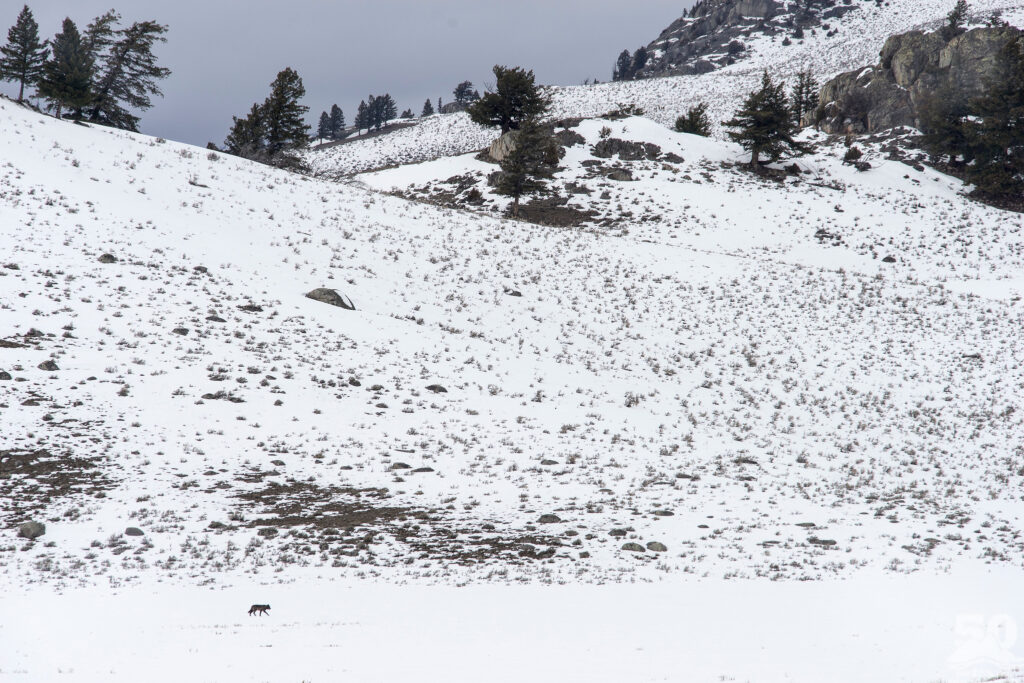Why is it that wolves are so addicting to watch? Although wolves seldom come close enough to photograph, people gather from across the world just to watch them. We watch them for hours and hours despite physical inconveniences — the strain in our eyes as we squint through spotting scopes, the long hours of tedium when wolves are inactive, the weather conditions that run from pleasant to brutal. Why is that wolves attract this level of fascination?
Wolves live in families ranging from a single pair with pups to a large extended family. As a human watching wolves, no matter who you are and where you come from, you have your own family experiences to relate to. Watching two wolf sisters squabble over the alpha position, the patient big uncle allowing his brother’s pups to climb all over him, the peaceful feeling of napping in the sun with your family after a big meal — these are all behaviors we’ve seen wolves perform in the wild, and can relate to. The body language of wolves, so similar to our own dogs, is much easier to interpret than that of a bison or a bear.
The dramatic plot twists in the life of a wolf are like those of a soap opera or sports team. Their stories are just as addicting to follow as every month can bring dramatic changes. Prey abundance or scarcity makes a wolf pack confident or desperate. There are neighboring packs looking to expand their territory, lone wolves looking for a mate, or the occasionally fatal risk of hunting large prey two to ten times your own size — a single day of good or bad fortune can change everything. With roughly 80-100 wolves scattered over Yellowstone’s 2.2 million acres, there are few enough wolves near the road system that we can get to know individuals and follow the course of a family story through the years.
But ultimately, wolves are so alluring to their fans because they are a symbol of true wilderness. When we watch wolves traveling across a meadow, each paw print touches land that is wild and intact enough to support wolves. They have not been able to adapt to the presence of humans as have the other wild canids of North America: foxes and coyotes. Seeing a fox trot across a golf course is a great experience in its own right. But wolves can only be found in places that connect with an increasingly rare moment of raw and untamed nature. Previous generations of Americans had more intimate connections with nature, even if it was just seeing the stars in a night sky free of light pollution or dealing with the realities of living without heat or air conditioning.
When we watch wolves in the wild, it can only be while we are immersed in the wild, natural conditions that our ancestors lived with for thousands of years. These interactions with the natural world, both obvious and subtle, make the experience of wild wolf watching impossible to stream over the internet, duplicate in captivity, or observe in our backyards. The cold weather and patient hours of searching bring the authenticity of the experience into sharper relief. Memories stand out more vividly in our minds without the distractions of cell service and the roar of highways in the background. This is why we watch wolves.
Interested in watching wolves in Yellowstone this winter?
This post was guest written by Wildlife Expeditions guide, Sarah Ernst. Sarah is a passionate educator that has been guiding for Wildlife Expeditions since 2011. She loves using stories, science, and dialogue to help her guests learn, connect, and form a deeper relationship with the national parks as well as their own home ecosystem. She received her Bachelor of Arts in Philosophy from Mount Holyoke College in South Hadley, MA in 2005. Prior to arriving in Jackson Hole, Sarah was the Education and Exhibits Coordinator at Kiawah Island Nature Center in South Carolina. In her free time Sarah enjoys exploring the Greater Yellowstone Ecosystem with hiking boots, kayaks, skis, and snowshoes – usually accompanied by her loyal dog Linus.


